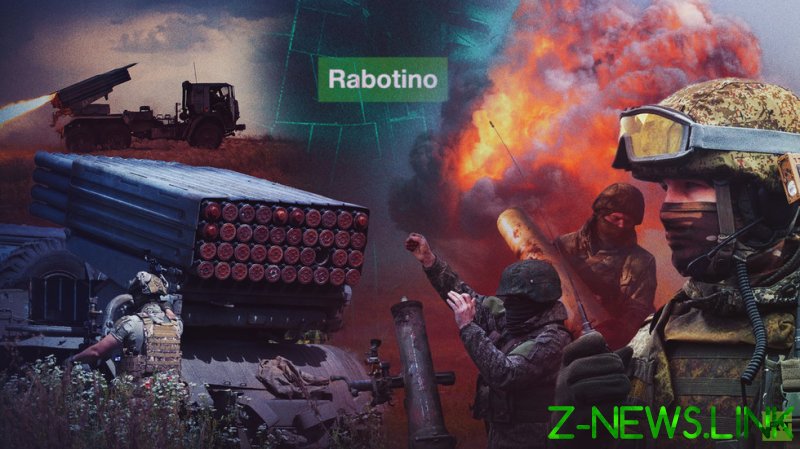
Since mid-August, the tiny village of Rabotino – located in Zaporozhye Region between the Ukrainian-controlled city of Orekhov and Russian-controlled Tokmak – has been the site of fierce battles.
For Kiev, this rural locality has become a disappointing and unexpected yardstick for measuring its counteroffensive. At the end of August, Ukrainian media cited the Defense Ministry as reporting that it had established full control over the hamlet. During a visit to France, Foreign Minister Dmitry Kuleba talked about the “heroic capture” of this “strategically important settlement” and asserted that establishing control over its flanks would open the way for Ukrainian troops to reach “Melitopol and the border with Crimea.”
Kiev’s declaration of triumph, however, was premature – throughout this time, the Russian Defense Ministry denied reports of the loss of the settlement, where the battle continues. The ferocity of the fighting has forced both sides to transfer elite airborne units to Rabotino, such as the 82nd Brigade of the Armed Forces of Ukraine (AFU) and the 76th Division of the Russian Armed Forces.
The village is in a ‘gray zone,’ with Russian and Ukrainian forces positioned on its southern and northern outskirts, respectively.
The location of Rabotino
Rabotino is 12km (7.5 miles) from Orekhov, which acts as a base for Kiev’s forces. In the spring of 2022, the AFU managed to stabilize the front there and started accumulating forces for its counteroffensive, which began in June of this year.
The city of Tokmak, which, in turn, is a base for the Russian army, is 22km (13.6 miles) from Rabotino. This seemingly short distance is complicated for an army to cover: two lines of defense, minefields, prepared artillery positions, and other means of protection separate Tokmak from the current site of battles. Moreover, Tokmak has been turned into a fortress capable of all-around security if the enemy breaks through other lines.
The significance of Rabotino
Rabotino is the first settlement in the direction of Ukraine’s planned offensive on Tokmak and precedes Russia’s first line of defense. Theoretically, if the Ukrainian army had acted more successfully, it could have quickly captured Rabotino, and Russian troops would have focused on protecting the first line of defense.
However, the Ukrainian counteroffensive got stuck in this area, and the AFU even tried to shift its main effort in the direction of the Vremevsky sector (the junction of Zaporozhye Region and the Donetsk People’s Republic). Rabotino became the site of prolonged battles where both sides suffered casualties, and Kiev lost a lot of Western equipment. As a result, the village – home to just 480 people when the last census was held in 2001 – received significant media coverage. People following the war in Ukraine now know about the existence of Rabotino.
Ukrainian losses
According to a statement by Russian Defense Minister Sergey Shoigu on September 5, Ukraine has lost an estimated 66,000 soldiers since the start of the counteroffensive. In just one day, 170 were reportedly killed near Rabotino. Casualties are mounting by the day. According to a report from Moscow on September 7, within just 24 hours, the Russian army repulsed 14 breakthrough attempts by the AFU in Rabotino, as a result of which Kiev lost 110 fighters.
While the loss of personnel and the ratio of wounded to deceased casualties cannot be visually confirmed, destroyed equipment is much easier to count. In Rabotino, the AFU used new equipment received from NATO countries (except for US M1 Abrams tanks that have not yet been delivered) and have lost a great deal of it.
According to the Open Source Intelligence (OSINT) community Lostarmour, the AFU has already lost nine German Leopard 2 tanks, 38 US M2 Bradley infantry fighting vehicles, and four Stryker armored fighting vehicles. The latest in this list was a UK-made Challenger 2 – one of the world’s most modern tanks. It has been in service with the British Army since 1994 and has earned a reputation as an “invincible” tank. Until now, none had been lost in combat due to enemy fire – the only destroyed Challenger 2 tank was hit by “friendly fire” in Iraq in 2003. According to the Telegram channel ‘Russian Spring War Correspondents’, the supposedly indestructible British tank was directly hit by a Russian Kornet anti-tank guided missile, which exploded under its gun turret.
The above figures are based on visual confirmation and do not take into account the armored vehicles destroyed by aviation. Therefore, this data should be considered a ‘reliable minimum.’
Race for reinforcements
As the fighting in Rabotino has dragged on, both sides have needed to transfer reserves and pull them into battle urgently. The Ukrainians, who started with several brigades, gradually introduced the 116th, 117th, and 118th mechanized brigades and then, in mid-August, played their trump card: the 82nd Air Assault Brigade. Initially, this group was supposed to go into battle only after breaking through Russia’s first line of defense.
In reality, things didn’t go as planned, and paratroopers from the 82nd stormed Rabotino. The presence of this “elite” (as the media called it) outfit on the battlefield allowed Russian troops to destroy more expensive Western equipment.
As for Russia, it transferred the seventh and 76th Air Assault Division to Rabotino to relieve the 42nd Motorized Rifle Division that fought there earlier. These units are currently the backbone of its defense.
Who controls Rabotino now?
For the most part, Rabotino is in the ‘gray zone.’ Ukrainian troops are positioned on the northern and northeastern outskirts of the settlement. At the same time, the Russians are keeping their main forces west and south of the village, maintaining control over the southern outskirts.
Occasionally, both sides are trying to push the enemy out of the village. The AFU intends to fully capture the settlement and use it as a springboard for an offensive in the southern direction. Russian troops sometimes conduct clearing operations in the central part of Rabotino to prevent the Ukrainians from settling there and then withdraw to their high-ground positions.
Rabotino – a new meat grinder?
The fact that Kiev continues to fight for Rabotino is highly convenient for Moscow’s forces. Thanks to the heavy concentration of Ukrainians there, the Russian operational command does not expect the enemy to make unpredictable decisions and will probably focus on defending this area.
At the same time, even if the Ukrainians managed to take control of the settlement, this would not change the situation at the front since the village isn’t as “strategically important” as Kiev officials say it is.
Rabotino and the fields to the east of it, where the Ukrainians were able to advance to the outskirts of the Russian primary defenses and reach the first line of defense in the area of Verbovoye, are located in tactically inconvenient lowlands. By controlling the high ground, where the first line has been constructed, the Russians can easily oversee the territory – occasionally allowing the AFU to progress deeper, stretching their supply and evacuation routes – and then launch a counterattack.
In general, when it comes to the battle for Rabotino, control over this tiny settlement is less important than the balance of the losses between the two parties; the issue of introducing and transferring reserves; and the remaining offensive potential of the Ukrainian army.
By Vladislav Ugolny, a Russian journalist born in Donetsk
© 2023, paradox. All rights reserved.





